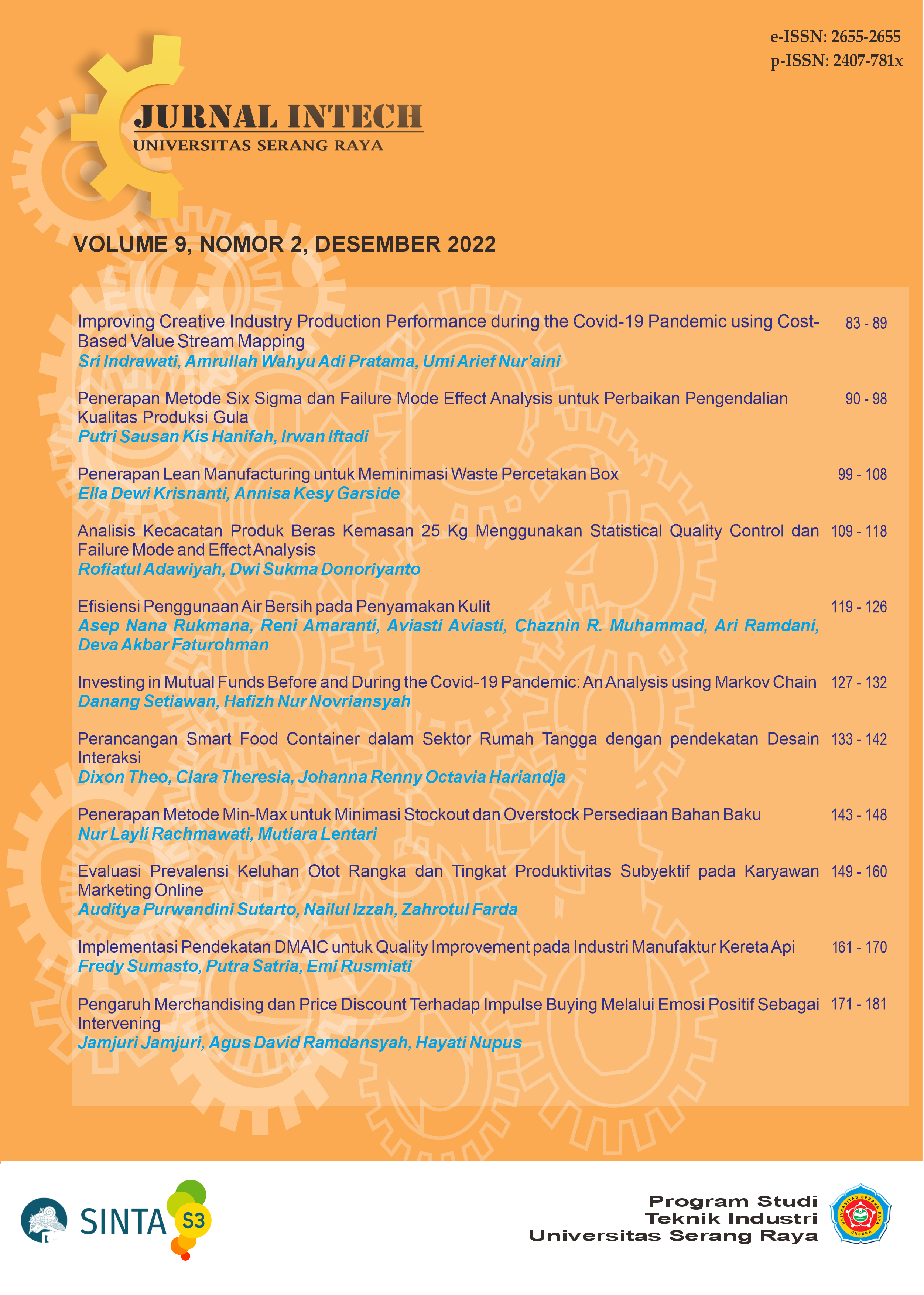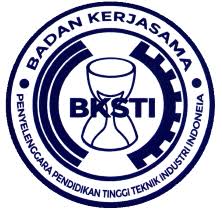Evaluasi Prevalensi Keluhan Otot Rangka dan Tingkat Produktivitas Subyektif pada Karyawan Marketing Online
DOI:
https://doi.org/10.30656/intech.v8i2.5011Keywords:
Individual Work Performance, Musculoskeletal Disorders, Nordic Body Map, Produktivitas, Rapid Office Strain Assessment (ROSA)Abstract
Karakteristik pekerja marketing online dapat dikategorikan sebagai office work yang berhubungan erat dengan interaksi antara pekerja dengan komponen dalam stasiun kerja. Pekerja menghabiskan sebagian besar waktu dalam posisi duduk di depan komputer yang berkaitan dengan risiko munculnya keluhan otot rangka atau musculoskeletal disorders (MSDs). Penelitian ini beÂrtujuan mengetahui tingkat keluhan nyeri otot, penilaian faktor risiko postur kerja, dan tingkat produktivitas individu secara subyektif. Penelitian ini bersifat deskriptif cross-sectional dengan subyek 30 pekerja sales online (total sampling). Pengukuran tingkat keluhan MSDs secara subyektif dilakukan dengan kuesioner Nordic Body Map, penilaian faktor risiko postur kerja mengÂgunakan Rapid Office Strain Assessment (ROSA), dan tingkat produktivitas individu dengan Individual Work Performance Questionnaire (IWPQ). Hasil penelitian menunjukkan 90% pekerja mengeluhkan gangguan pada paling sedikit satu anggota tubuh baik pada satu tahun atau tujuh hari terakhir. Rataan skor ROSA untuk seluruh responden sebesar 7,97 yang mengindikasikan perlu perbaikan segera. Tingkat laporan diri produktivitas individu secara umum cukup baik. Namun demikian, pekerja yang mengalami keluhan di bagian tubuh tertentu cenderung melaporkan tingkat produktivitas lebih rendah dibandingkan mereka yang tidak mengalami. Usulan perbaikan yang dapat dilakukan mencakup perbaikan fasilitas kerja dan organisasi kerja seperti pengaturan waktu istirahat, peregangan, dan ergonomi partisipatori.
Downloads
References
Ahmad, N. F., & Maesa. (2021). Evaluasi Office Ergonomic di PT . NDM dengan Metode Rapid Office Strain Assessment ( ROSA ). TEKINFO - Jurnal Ilmiah Teknik Indusri Dan Informasi, 10(1), 15–19. https://doi.org/10.31001/tekinfo.v10i1.1296
AlOmar, R. S., AlShamlan, N. A., Alawashiz, S., Badawood, Y., Ghwoidi, B. A., & Abugad, H. (2021). Musculoskeletal symptoms and their associated risk factors among Saudi office workers: a cross-sectional study. BMC Musculoskeletal Disorders, 22(1), 763. https://doi.org/10.1186/s12891-021-04652-4
Bagheri, S., & Ghaljahi, M. (2019). Ergonomic Evaluation of Musculoskeletal Disorders with Rapid Office Strain Assessment and Its Association with Occupational Burnout among Computer Users at Zabol University of Medical Sciences in 2017. Asian Journal of Water, Environment and Pollution, 16(1), 91–96. https://doi.org/10.3233/AJW190010
Campbell, J. P., & Wiernik, B. M. (2015). The Modeling and Assessment of Work Performance. Annual Review of Organizational Psychology and Organizational Behavior, 2, 47–74. https://doi.org/10.1146/annurev-orgpsych-032414-111427
Dåderman, A. M. (2020). Cross-Cultural Adaptation, from Dutch to Swedish Language, of the Individual Work Performance Questionnaire. Work, 65(1), 97–109. https://doi.org/10.3233/WOR-193062
Farid, M., & Neumann, W. P. (2020). Modelling the effects of employee injury risks on injury, productivity and production quality using system dynamics. International Journal of Production Research, 58(20), 6115–6129. https://doi.org/10.1080/00207543.2019.1667040
Gao, R. (2020). Basic Ergonomics For Your Home Office. https://www.chatelaine.com/home-decor/home-office-ergonomics-faq/
Hämäläinen, P., Takala, J., & Kiat, T. B. (2017). Global Estimates of Occupational Accidents and Work-Related Illnesses 2017. In WSH Institute. https://doi.org/10.1109/IECON.2006.347617
Hoe, V., Urquhart, D., Kelsall, H., Zamri, E., & Sim, M. (2018). Ergonomic interventions for preventing work-related musculoskeletal disorders of the upper limb and neck among office workers. Cochrane Database of Systematic Reviews, 10, CD008570. https://doi.org/10.1002/14651858
Jusoh, F., & Zahid, M. N. O. (2018). Ergonomics Risk Assessment among support staff in Universiti Malaysia Pahang. IOP Conference Series: Materials Science and Engineering, 319(1), 1–6. https://doi.org/10.1088/1757-899X/319/1/012059
Kawai, K., Kawai, A. T., Wollan, P., & Yawn, B. P. (2017). Adverse impacts of chronic pain on health-related quality of life, work productivity, depression and anxiety in a community-based study. Family Practice, 34(6), 656–661. https://doi.org/10.1093/fampra/cmx034
Kementerian Kesehatan RI. (2019). Hasil Riset Kesehatan Dasar Tahun 2018. https://www.litbang.kemkes.go.id/laporan-riset-kesehatan-dasar-riskesdas/
Kogi, K., & Yoshikawa, T. (2016). Low-Cost Improvements for Reducing Multifaceted Work-Related Risks and Preventing Stress at Work. Journal of Ergonomics, 6(1), 1–7. https://doi.org/10.4172/2165-7556.1000147
Koopmans, L. (2016). Cross-cultural adaptation of the Individual Work Performance Questionnaire. Work, 53(3), 609–619. https://doi.org/10.3233/WOR-152237
Koopmans, L., Bernaards, C., Hildebrandt, V., Van Buuren, S., Van Der Beek, A. J., & de Vet, H. C. w. (2012). Development of an individual work performance questionnaire. International Journal of Productivity and Performance Management, 62(1), 6–28. https://doi.org/10.1108/17410401311285273
Kroemer, A. D., & Kroemer, K. H. E. (2016). Office Ergonomics. CRC Press. https://doi.org/10.1201/9781315368603
Kuorinka, I., Jonsson, B., Kilbom, A., Vinterberg, H., Biering-Sørensen, F., Andersson, G., & Jørgensen, K. (1987). Standardised Nordic questionnaires for the analysis of musculoskeletal symptoms. Applied Ergonomics, 18(3), 233–237. https://doi.org/10.1016/0003-6870(87)90010-X
Lim, Y. Z., Chou, L., Au, R. T., Seneviwickrama, K. M. D., Cicuttini, F. M., Briggs, A. M., Sullivan, K., Urquhart, D. M., & Wluka, A. E. (2019). People with low back pain want clear, consistent and personalised information on prognosis, treatment options and self-management strategies: a systematic review. Journal of Physiotherapy, 65(3), 124–135. https://doi.org/10.1016/j.jphys.2019.05.010
Madeleine, P., Vangsgaard, S., Hviid Andersen, J., Ge, H.-Y., & Arendt-Nielsen, L. (2013). Computer work and self-reported variables on anthropometrics, computer usage, work ability, productivity, pain, and physical activity. BMC Musculoskeletal Disorders, 14(1), 226. https://doi.org/10.1186/1471-2474-14-226
Matos, M., & Arezes, P. M. (2015). Ergonomic Evaluation of Office Workplaces with Rapid Office Strain Assessment (ROSA). Procedia Manufacturing, 3(Ahfe), 4689–4694. https://doi.org/10.1016/j.promfg.2015.07.562
McDonald, M., Dibonaventura, M. D., & Ullman, S. (2011). Musculoskeletal pain in the workforce: The effects of back, arthritis, and fibromyalgia pain on quality of life and work productivity. Journal of Occupational and Environmental Medicine, 53(7), 765–770. https://doi.org/10.1097/JOM.0b013e318222af81
Rahayu, P. T., Arbitera, C., & Amrullah, A. A. (2020). Hubungan Faktor Individu dan Faktor Pekerjaan terhadap Keluhan Musculoskeletal Disorders pada Pegawai. Jurnal Kesehatan, 11(3), 449. https://doi.org/10.26630/jk.v11i3.2221
Ramdani, Z., Marliani, R., & Rahman, A. A. (2019). The individual work performance scale: A psychometric study and its application for employee performance. Humanities and Social Sciences Reviews, 7(5), 405–414. https://doi.org/10.18510/hssr.2019.7545
Ramos-Villagrasa, P. J., Barrada, J. R., Fernández-del-RÃo, E., & Koopmans, L. (2019). Assessing Job Performance Using Brief Self-report Scales: The Case of the Individual Work Performance Questionnaire. Revista de PsicologÃa Del Trabajo Y de Las Organizaciones, 35(3), 195–205. https://doi.org/10.5093/jwop2019a21
Restuputri, D. P., Puspita, D., & Mubin, A. (2019). Pengukuran Risiko Kerja dan Lingkungan Fisik pada Departemen IT dengan Menggunakan Metode Rapid Office Strain Assessment (ROSA). Jurnal Optimasi Sistem Industri, 18(2), 125–132. https://doi.org/10.25077/josi.v18.n2.p125-132.2019
Rodrigues, M. S. A., Leite, R. D. V., Lelis, C. M., & Chaves, T. C. (2017). Differences in ergonomic and workstation factors between computer office workers with and without reported musculoskeletal pain. Work, 57(4), 563–572. https://doi.org/10.3233/WOR-172582
Salim, Z., & Ernawati, E. (2015). Info Komoditi Pakaian Jadi. AMP Press. https://erepository.uwks.ac.id/6397/1/12. Pakaian Jadi Indonesia Dalam Perspektif.pdf
Sasikumar, V., & Binoosh, S. champakkadayil A. basheer. (2020). A model for predicting the risk of musculoskeletal disorders among computer professionals. International Journal of Occupational Safety and Ergonomics, 26(2), 384–396. https://doi.org/10.1080/10803548.2018.1480583
Siboro, B. A. H. (2019). Analisa Postur Tubuh Kegiatan Input Data pada PT ABC. Jurnal Ergonomi Dan K3, 4(1), 1–6. https://doi.org/10.5614/j.ergo.2019.4.1.1
Simons, G., Lumley, S., Falahee, M., Kumar, K., Mallen, C. D., Stack, R. J., & Raza, K. (2017). The pathway to consultation for rheumatoid arthritis: exploring anticipated actions between the onset of symptoms and face-to-face encounter with a healthcare professional. BMC Musculoskeletal Disorders, 18(1), 258. https://doi.org/10.1186/s12891-017-1619-9
Sonne, M., Villalta, D. L., & Andrews, D. M. (2012). Development and evaluation of an office ergonomic risk checklist: ROSA - Rapid office strain assessment. Applied Ergonomics, 43(1), 98–108. https://doi.org/10.1016/j.apergo.2011.03.008
Sutarto, A. P., Wardaningsih, S., & Putri, W. H. (2021). Work from Home: Indonesian Employees’ Mental Well-Being and Productivity during the COVID-19 Pandemic. International Journal of Workplace Health Management, 14(4), 386–408. https://doi.org/10.1108/IJWHM-08-2020-0152
Ünay, F. G., & Zehir, C. (2012). Innovation intelligence and entrepreneurship in the fashion industry. Procedia - Social and Behavioral Sciences, 41, 315–321. https://doi.org/10.1016/j.sbspro.2012.04.036
Veale, D. J., Woolf, A. D., & Carr, A. J. (2008). Chronic musculoskeletal pain and arthritis: impact, attitudes and perceptions. Irish Medical Journal, 101(7), 208–210. https://pubmed.ncbi.nlm.nih.gov/18807810/
WHO. (2021). Musculoskeletal conditions. https://www.who.int/news-room/fact-sheets/detail/musculoskeletal-conditions
Widanarko, B., Kusmasari, W., Yassierli, Y., & Iridiastadi, H. (2016). Instrumen Survei Gangguan Otot-Rangka. Perhimpunan Ergonomi Indonesia. https://pei.or.id/survey-keluhan-gangguan-otot-rangka
Widyastuti, T., & Hidayat, R. (2018). Adaptation of Individual Work Performance Questionnaire (IWPQ) into Bahasa Indonesia. International Journal of Research Studies in Psychology, 7(2), 101–112. https://doi.org/10.5861/ijrsp.2018.3020









.png)
.png)
.png)



.png)

.png)
